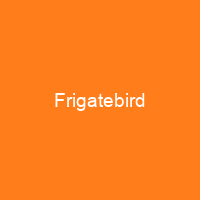Frigatebirds are a family of seabirds called Fregatidae which are found across all tropical and subtropical oceans. The five extant species are classified in a single genus, Fregata. All have predominantly black plumage, long, deeply forked tails and long hooked bills.
About Frigatebird in brief

It lives on Fish yet never lights on the water, but soars aloft like a Kites, and when it sees its prey, it flys down head foremost to the Waters edge, very swiftly takes its prey out of the Sea with his Bill, and immediately mounts again as swiftly; never touching the Water with hisBill. It is a sister group to Suloidea which consists of cormorants, darters, gannets, and boobies. Three of the five species are widespread, while two are endangered and restrict their breeding habitat to one small island each. The term Frigate Bird itself was used in 1738 by theEnglish naturalist and illustrator Eleazar Albin in his A Natural History of the Birds. The genus F Regata was defined by French naturalist Germain de Lacépède de Tachypéde in 1816 for the great great frigate bird. The German naturalist Paul Möhring coined the name Atagenetes in 1752, though this has no validity as predates the official taxonomy of the family. Not74, English zoologist Alfred Henry Garrod published a study where he examined a selected group of five groups of birds and recorded which muscles they lacked.
You want to know more about Frigatebird?
This page is based on the article Frigatebird published in Wikipedia (as of Nov. 07, 2020) and was automatically summarized using artificial intelligence.







